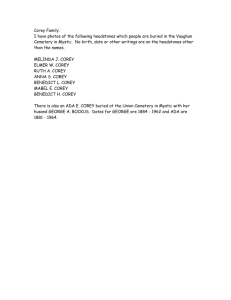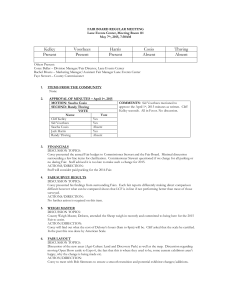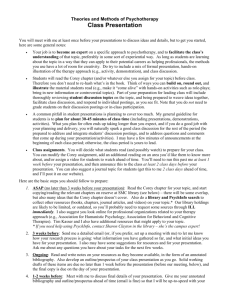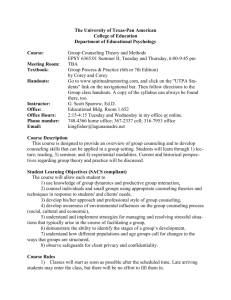An Eclectic Approach to the Group Counseling
advertisement
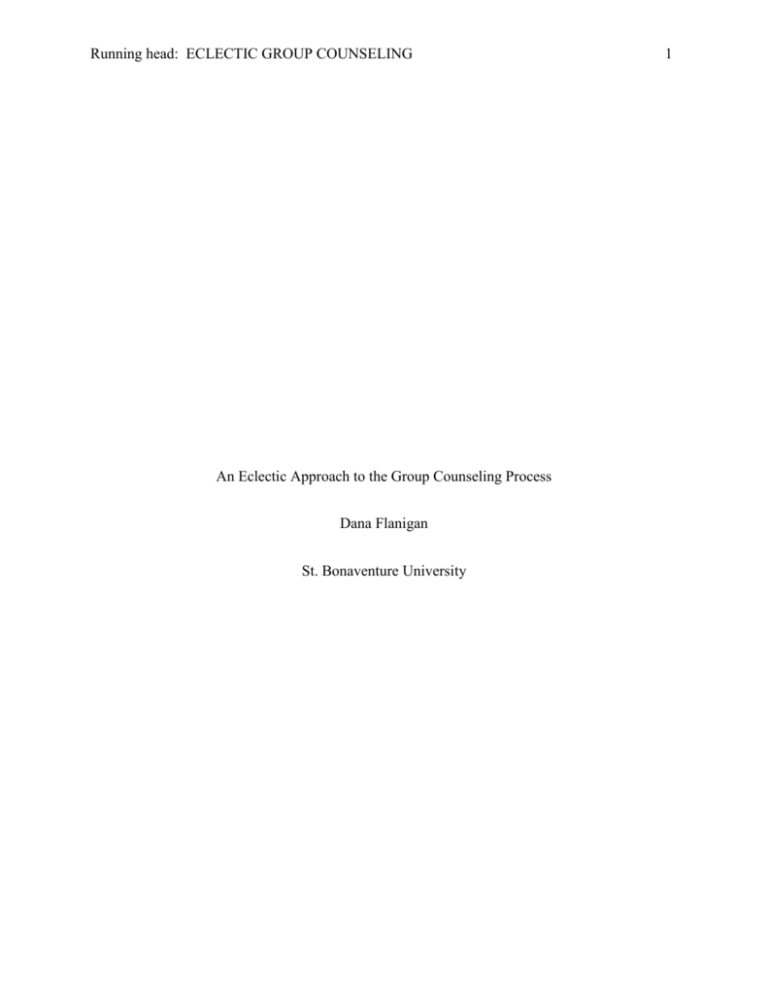
Running head: ECLECTIC GROUP COUNSELING An Eclectic Approach to the Group Counseling Process Dana Flanigan St. Bonaventure University 1 ECLECTIC GROUP COUNSELING 2 As every year passes, the counseling profession continues to go through many changes and evolutions. One of the more recent changes has been the focus being placed on the therapeutic method being utilized. Throughout the history of the profession, individual counseling has been a mainstay for providing adequate therapeutic intervention. Recently, there has been a great deal of research disputing the effectiveness of individual counseling (Fiorentine, 2001). Rather, researchers are supporting the notion that group counseling is the most effective therapeutic strategy and it is direction the profession is heading (Towberman, 1993). Group counseling is a process that goes through several stages, all of which contain specified guidelines for implementing a successful strategy and achieving a positive outcome for the members of the group. Agencies all over the U.S. and the rest of the world have had a surge of interest in the use of group work in the present times (Corey, 2008). Much of this is thought to be due to the unique elements that the group experience provides to the therapeutic process. For instance, the group experience provides an opportunity for several people to engage in therapy that have either the same or similar issues (Corey, 2008). This creates an opportunity for a camaraderie amongst individuals who can join forces to face the mutual deterrents that is causing irregularities in their lives. For individuals who are battling the issue of substance abuse; the group process can be a very effective weapon. If group counseling is going to be an effective tool, the leader must have a strong theoretical base and the ability to utilize these theories in a creative manner throughout the group process (Corey, 2008). There are just a few suggestions made by Gerald Corey. First, it is imperative that you know your personality, values, beliefs, and personal characteristics before developing your leadership style. Second, if you copy someone else’s style than you could lose ECLECTIC GROUP COUNSELING 3 effectiveness; just because it was successful for them, does not mean that it will be effective for you. Third, when utilizing one of the theories, continue to question and challenge that theoretical approach and do not just go through the motions (Corey, 2008). Keeping this message in mind, the theoretical approach that best fits my leadership style would be Adlerian. The Adlerian approach focuses less on biology and more on the social determinants and idiosyncratic views that affect our behaviors and overall development. Adlerianism puts a real focus on the holism of the individual, as well as many other key concepts that corresponds greatly with my personal outlook on life. However, I see many values in many of the other theories that could potentially serve me just as much justice. For several decades, all of the theoretical orientations have been battling against one another to establish efficacy of different approaches (Norcross, & Goldfried, 2005). In which case, there is a great deal of evidence of what treatments work best for many of the primary clinical disorders and issues (Norcross, & Goldfried, 2005). Norcross and Goldfried have proposed that we shift our energies from focusing on comparable means and place the attention on creating a more adequate eclectic approach. Therefore, using an eclectic approach corresponding with an adlerian base would be a productive method when working through the stages of the group process. Stage 1: Pregroup issues – Formation of the Group The steps involved in the process of formulating a group are extremely important as they lay the groundwork for the whole process. Prior to starting a group, the group leader can enhance the planning process by outlining a written proposal for the prospective group (Corey, 2008). Using this format, a leader could see many of the pregroup issues and handle them appropriately before the therapeutic interaction takes place. As the leader of a substance abuse ECLECTIC GROUP COUNSELING 4 group, there are several Pregroup issues that would need to be addressed during formulation. For instance: the screening of potential members; the size, frequency, and length of the group; as well as the structure in which the group is to be run. Research indicates that of the individuals who have alcohol or other drug problems (AOD), only a small percentage of them seek help voluntarily and most of them end up dropping out (Burke, & Gregoire, 2007). On the other hand, individuals who are coerced into a treatment program generally are unwilling to develop therapeutic relationships and often are not motivated to partake in the treatment (Burke, & Gregoire, 2007). This is a clear challenge to any practitioner who is formulating a substance abuse group. A key strategy could be in the attitudes and motivations of the potential group members. During the screening process, the practitioner could evaluate clients from several treatment programs. Also, allow noncoerced clients an opportunity to seek help through the program. If individuals are screened properly, the practitioner should have a chance to uncover the potential members who truly desire the treatment; regardless of the pressures of having voluntary or involuntary status. When the practitioner has properly screened individuals, they must then decide some of the intimate details of the process. First, in substance abuse therapy, camaraderie is an important tool that works toward a successful outcome. Therefore, the group should be a closed group with approximately 8 members per practitioner (Corey, 2008). Second, in substance abuse therapy, consistency is crucial to individuals who battle their substance abuse issues every day. Therefore, the group should meet at least once a week for 90 minute periods (Corey, 2008). However, both should be left open to the essence of the treatment. If the group members request more days or an extension of time in a session, they should be accommodated by the practitioner. ECLECTIC GROUP COUNSELING 5 When creating the structure of the group, there are several facets that are involved. First, the practitioner creates the group and selects members based around their need for the group. Then the practitioner institutes more structure during the screening and initial interview. At these times, I would indicate to the members what kinds of things they could expect during the process as well as expectations we both may have. If the group leader needs to add more structure to the group, as they often do with substance abuse groups, there is another option. In the Transactional Analysis theory, they have a technique known as contracting. In contracting, the group members agree to several terms that provide structure, yet it does not hamper the spontaneity aspect of the process. The most appropriate time to distribute this type of contract would be during the initial interview, prior to the first session (Corey, 2008). Stage 2: Initial Stage – Orientation and Exploration The initial stage is crucial for the members to become acquainted and comfortable with the rest of the group, their surroundings, and the structure of the group. At the onset of this stage, one of the most significant factors deals with the concept of trust. There are several relationship-oriented approaches that help build a strong foundation of trust within the group, such as person-centered therapy, existential therapy, Gestalt therapy, and psychodrama (Corey, 2008). These approaches effectively instill trust in the members of the group for several reasons. First, it provides the leader an opportunity to set the tone by modeling empathy and a basic respect for what the members are experiencing. Second, the members would gain trust as they learned more about each other as well as expressed more about themselves. In psychodrama, there is a technique known as the warm-up phase (Corey, 2008). This method provides gradual increase in the involvement and spontaneity in the group, which in turn can enhance comfort and trust. ECLECTIC GROUP COUNSELING 6 The initial stage is also an important time to implement the goals to be achieved through the group process. To this point, the members have gained an understanding to the group structure, and at least have a sense of themselves and where the other members are in the group. During the portion of the group process dealing with the defining of personal goals, the Adlerian approach is highly valued for their concept of goal alignment (Corey, 2008). A major innovation of the Adlerian approach was the emphasis on self-created goals as the source of motivation and dynamic functionalism (Dreikurs-Ferguson, 2003). Adlerian’s also place a great deal of emphasis on subjective future orientations the guiding principle for psyche phenomena, which was a major breakthrough in conceptualizing human thinking, feeling, and action (DreikursFerguson, 2003). Stage 3: Transition Stage – Dealing with Resistance The most challenging period of the group process typically transpires during the transition stage. In order for the group to move into the working stage, several problematic behaviors need to recognized and dealt with, such as; anxiety, defensiveness, resistance, conflict, the struggle for control, challenges to the leader, and other things of that nature (Corey, 2008). If the practitioner does not respond to these challenges effectively, the group can get stuck in this stage. It is important that the group leader views resistance as a normal and healthy sign of the group’s movement toward autonomy (Corey, 2008). As the leader, you must not view these natural reactions as nuisances and rather help members deal with sources of behavior in a therapeutic way (Corey, 2008). There are several theoretical approaches that give insight to group leaders on how a situation of resistance should be handled. In a substance abuse group, I might consider ECLECTIC GROUP COUNSELING 7 combining two theoretical perspectives. If you were to combine Adlerian and psychoanalytic views, the resisting members might be able to re-experience some of the old feelings from their original family; perhaps in a childhood trauma or sibling rivalry (Corey, 2008). Often times, members of the group are resisting because they are stuck, in a developmental sense. For this reason, having members re-experience these unexplored situations can prevent these feelings from preventing them from the ability to function effectively (Corey, 2008). Stage 4: Working Stage – Cohesion and Productivity During this stage, the members really pull together and make efficient strides in getting the most out of there group experience (Corey, 2008). This is where members explore significant issues that they bring to the group with the others. At this stage, members are feeling more comfortable and are willing to reveal more about themselves. However, the work of the group leader is not over. It is the job of the leader is to further assist the group members to get in touch with their feelings. Typically, using an experimental approach would be the most effective way to accelerate this process. In my group, I would use the experimental approach with either Gestalt or Psychodrama. For instance, if one of the members felt bottled up feelings about some of the ways his wife treated him when he was drinking before she took the kids and moved to Florida. I might use Gestalt and have the individual play the role of himself and his wife and allow him to have the conversation he has anticipated for years. Stage 5: Final Stage – Consolidation and Termination The final stage of the group process is critical. It is in this stage where the members of the group consolidate all of the feelings, meanings, and experiences that transpired while they were in the group process. If the members do not clarify all the meanings of what they learned then their ECLECTIC GROUP COUNSELING 8 group experience may end up being unsuccessful. The major challenge of this stage is for the members to learn ways to maintain these new behaviors in the real world when the group experience is over (Corey, 2008). At the end of the group process, the leader must review the progress of his members. There are several questions they must use for such a review. All of the questions are indicative of the personal growth they experienced and strategies they have formed to maintain their improved sense of self. In this stage, the most appropriate approaches would deal with behavior therapy such as Cognitive behavior therapy, transactional analysis, REBT, reality therapy, and solution-focused brief therapy. These models are very important at this stage in the group process because they stress the importance of developing specific plans for change, how to make the change happen, and evaluate the positives outcomes of the change (Corey, 2008) Stage 6: Post-Group Issues – Evaluation and Follow-up This stage signifies that the group process has come to an end. However the work the leader and his members is not finished. It is during this stage that the leader gives the members an action plan for their everyday life, so that they can function in a self-directed way (Corey, 2008). In my group, I would end the therapeutic relationship with several steps so I can be certain that I did everything in my power to help the members of my group. I would have an individual session with each member following the final group session. I would then schedule with each member a follow-up group session for a couple months down the road. I would then schedule an individual session for a short period of time after that. In each of these meetings I would monitor all of the members carefully and try and be certain that they are living the lives that they were aspiring for during the stages of group that they expressed their goals. ECLECTIC GROUP COUNSELING 9 References Burke, A., & Gregoire, T. (2007). Substance abuse treatment outcomes for coerced and noncoerced clients. Health & Social Work, 32(1), 7-15. Retrieved from Academic Search Premier database. Corey, G. (2008). Theory and practice of group counseling. (7th ed.). Pacific Grove, CA: Brooks Cole. Dreikurs-Ferguson, E. (2003). Social processes, personal goals, and their intertwining: Their importance in Adlerian theory and practice. Journal of Individual Psychology, 59(2), 136-144. Retrieved from PsycINFO database. Fiorentine, R. (2001). Counseling frequency and the effectiveness of outpatient drug treatment: Revisiting the conclusion that “more is better.” American Journal of Drug & Alcohol Abuse, 27(4), 617. Retrieved from Academic Search Premier database. Norcross, J., & Goldfried, M. (2005). The future of psychotherapy integration: A roundtable. Journal of Psychotherapy Integration, 15(4), 392-471. doi:10.1037/1053-0479.15.4.392. Towberman, D. (1993). Group vs. individual counseling: Treatment mode and the client's perception of the treatment environment. Journal of Group Psychotherapy, Psychodrama & Sociometry, 45(4), 163-174. Retrieved from PsycINFO database.
